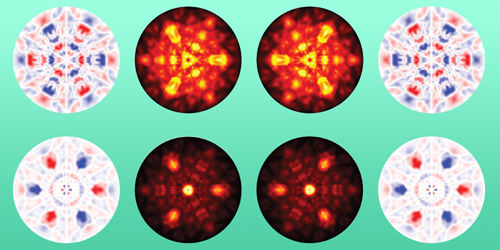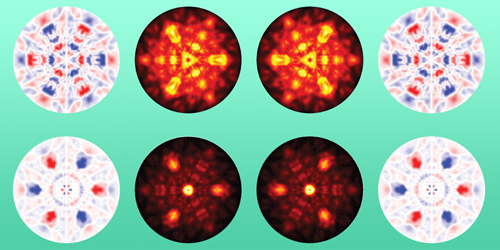November 6, 2025• Physics 18, s145
Two new techniques use circularly polarized x rays to characterize a new and potentially useful form of magnetism.
Like antiferromagnets, altermagnets lack net magnetization. Unlike antiferromagnets, they have electronic band structures that are split into spin-up and spin-down bands. This spin splitting makes altermagnets attractive for spin-based electronics, especially in combination with the fast switching times that altermagnets share with antiferromagnets. Most proposed devices are based on single altermagnetic domains, which have proven hard to fabricate. Although that challenge remains unmet, researchers have proposed in two independent studies techniques to accomplish a necessary first step: identifying and mapping the domains [1, 2].
Altermagnets owe their spin splitting to broken time-reversal symmetry: The spin-up and spin-down atomic lattices cannot be superposed on each other unless one lattice is rotated by a certain angle, often 180°. In the two studies—one by Peter Krüger of Chiba University in Japan and the other by Hakuto Suzuki of Tohoku University in Japan and his collaborators—the researchers propose to identify the telltale asymmetry by looking for differences in how a material responds to right- and left-circularly-polarized x rays. Their respective techniques differ in how they ensure that the signal comes from the altermagnet’s magnetically active element. The Chiba scheme looks at diffraction patterns formed by photoelectrons scattered off the surface and is sensitive to the ground-state spin structure [1]. The Tohoku scheme looks at inelastically scattered x rays from the bulk and is sensitive to spin-wave excitations, or magnons [2]. Both groups demonstrated the feasibility of their techniques using manganese telluride, with numerical simulations in the case of the Chiba group, and with an experiment in the case of the Tohoku group.
Since altermagnets were first recognized as a class three years ago, theorists have found numerous examples. The two new techniques could help experimenters determine the most promising materials to pursue for magnetoresistive random-access memories, spin current generators, and other potential devices.
–Charles Day
Charles Day is a Senior Editor for Physics Magazine.
ReferencesP. Krüger, “Circular dichroism in resonant photoelectron diffraction as a direct probe of sublattice magnetization in altermagnets,” Phys. Rev. Lett. 135, 196703 (2025).D. Takegami et al., “Circular dichroism in resonant inelastic x-ray scattering: Probing altermagnetic domains in MnTe,” Phys. Rev. Lett. 135, 196502 (2025).Circular Dichroism in Resonant Inelastic X-Ray Scattering: Probing Altermagnetic Domains in MnTe
D. Takegami, T. Aoyama, T. Okauchi, T. Yamaguchi, S. Tippireddy, S. Agrestini, M. García-Fernández, T. Mizokawa, K. Ohgushi, Ke-Jin Zhou, J. Chaloupka, J. Kuneš, A. Hariki, and H. Suzuki
Phys. Rev. Lett. 135, 196502 (2025)
Published November 6, 2025
Subject AreasMagnetismCondensed Matter PhysicsRelated Articles
 Condensed Matter PhysicsShining Light on AntiferromagnetsNovember 4, 2025
Condensed Matter PhysicsShining Light on AntiferromagnetsNovember 4, 2025
Researchers use a magneto-optical technique to image and manipulate magnetic domains in a chiral antiferromagnet, opening new routes for spin-based electronics. Read More »



